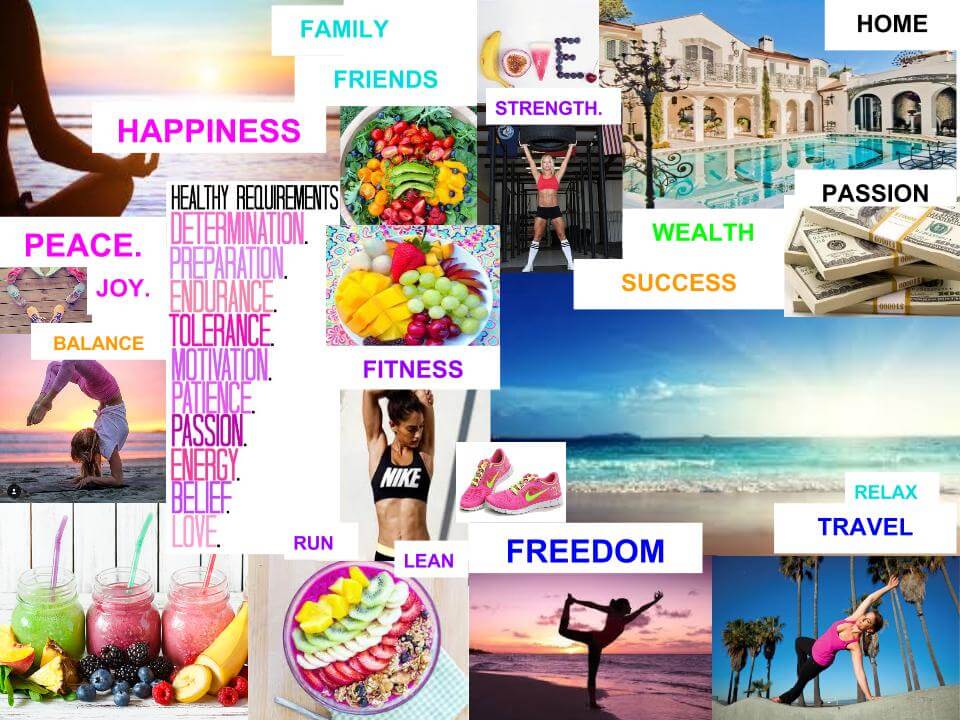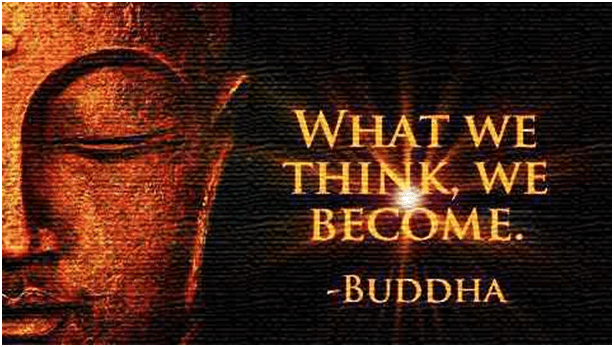What is a Vision Board?
A vision board is a simple, yet powerful, visualization tool that helps open the door to the universal ‘Law of Attraction’ and aids in manifesting your goals and dreams into reality.
The concept of the vision board (also known as a goal board, goal map, or treasure map) has been around for generations, but gained in popularity after success expert John Assaraf related his story, in the documentary “The Secret,” of using vision boards to achieve his dreams.
If you have not watched the documentary ‘The Secret,” I highly recommend doing so.
A vision board is simply a visual representation, or collage, of the things that you most desire. It consists of a poster, or foam board, with cut out pictures, drawings, and/or writing on it of the things that you want in your life or the things that you want to become. Vision boards can also be created using digital pictures and software. For example, digital pictures can be arranged in a word processing application. There are also web-based services like www.shapecollage.com and www.photovisi.com that can help you create a vision board by uploading and arranging your photos.

If the concept of the vision board has been around for generations, where did it originate?
American author Napoleon Hill (1883-1970) was considered to be one of the great writers on success. His most famous work, Think and Grow Rich, is one of the bestselling books of all time. Hill’s works examined the power of personal beliefs, and the role they play in personal success. “What the mind of man can conceive and believe, it can achieve” is one of Hill’s hallmark expressions. Although Napoleon Hill didn’t use the term ‘Law of Attraction’, he described the same process in detail in his book, Think and Grow Rich.
Is there science behind the ‘Law of Attraction’ theory?

The ‘Law of Attraction’ states that we attract into our lives anything that we give attention to—whether it be positive or negative. From a psychological view, the ‘Law of Attraction’ can be best explained by the information filtering system of the brain known as the reticular activating system (RAS).
Vision boards serve the role of programming the RAS to tune into external stimuli that can help us move closer towards our intentions.
At the base of the human brain stem, in between the medulla oblongata and the mesencephalon, there is a small finger-sized control center called the reticular activating system (RAS) that sorts and evaluates incoming data.
Your RAS is responsible for filtering all the incoming information that your brain receives, and it also acts as a receiver for information that is tagged as important.
A simple way to conceptualize the RAS is to think of it like a radio. You are surrounded by radio waves from various stations, but your portable radio can only tune-in to one at a time. So it is with manifesting. You must tune-in to what you most want or desire.
Is it important to use a person’s name when activating the ‘Law of Attraction’?
Yes, using a person’s name has power! It activates the RAS part of the brain. Imagine you are in a meeting room talking to several people and in the distant corner of the room you hear someone call your name. All of your focus gets diverted in the direction of the voice because that bit of information is tagged by the RAS as important to you.
The more you use a person’s name, the more alert and focused the brain becomes.
For example, your RAS is responsible for allowing you to sleep through the traffic noise outside but wakes you at the smallest cry from your infant child. Another example of the RAS at work is when you buy a new car and then realize that scores of people in your city have the same car.
Who conducted the RAS brain research and what was discovered?
According to Hans Morvec, the principal research scientist at the Robotics Institute of Carnegie Mellon University, the human brain can handle up to 100 trillion bits of information at any given time. The RAS can’t distinguish between a real event and a “created” reality. We can take advantage of this fact by programming our brain to seek out stimuli in our environment that resonates with our goals.
This is why visualization and hypnotherapy are such powerful tools in creating new realities.
How can creating a vision board activate the RAS?
The process of creating a vision board is one of the best ways to program the RAS because it programs the RAS to pay attention to certain things in your environment that are in frequency with your goal or vision, in much the same way as you are able to pick up your name being mentioned in a conversation on the other side of a room while talking to others.
HOW TO MAKE AND USE YOUR VISION BOARD
Your personal vision board is only limited by the extent of your own creativity. Having artistic ability is not a prerequisite for creating a functional vision board. Any size will do.
The elements of a well-designed vision board include:
- Visual. Your subconscious mind works in pictures and images, so make your vision boards as visual as possible, with as many pictures as possible. You may supplement your pictures with words and phrases to increase the emotional response you get from it.
- Emotional. Each picture on your vision board should evoke a positive emotional response from you. The mere sight of your vision board should make you happy, and fuel your passion to achieve your desires, every time you look at it.
- Strategically-placed. Your vision board should be strategically placed in a location that gives you maximum exposure to it. You need to constantly bathe your subconscious mind with its energy in order to quickly manifest your desires.
- Personal. Negative feelings, self-doubt, and criticism can damage the delicate energy that your vision board emits. If you fear criticism from others, then place it in a private location so it can only be seen by you.
Supplies Needed to Create a Vision Board:
- Foam core board or poster board
- A large assortment of magazines you can cut up or images downloaded from the Internet. You want to make sure your images are in color.
- Glue, adhesive or double sided tape
- Scissors
- Paper or large labels to print WORDS on that you may not be able to find in magazines
- Access to a printer to print WORDS or phrases you want to include on your board
- Any scrap booking supplies you want to use to augment the artistic value of your vision board
HOW TO MAKE YOUR VISION BOARD
Step 1- Compile your pictures
- Start by going through magazines and compiling all your pictures, words or quotes that you can find that are relevant to your goal.
- Don’t evaluate the pictures or start pasting them onto your board. Stack them into a pile, at first.
- If you want to use the Internet, do a search to find good pictures to use for your board. You can either print the pictures out on paper and then glue them to the board, or print the pictures out onto a self-adhesive label so that it becomes a sticker.
- Make sure that each image that you put on your board resonates with your heart and makes you excited.
- It’s also important that when selecting pictures to include anything that is congruent with your goal, such as any changes in your life that might result from obtaining your goal. If your goal is to have a six-figure income, then select pictures of a lifestyle that is in keeping with a six-figure income.
Asking yourself the following questions might help you design a congruent vision board:
- What would you do differently when you realize your goal?
- Where would you travel?
- Where would you live?
- What would you wear?
- What things would you own?
- What kind of vehicle would you drive? • What would you do for work? Or would you work? • Who would you help?
Step 2- Sort and Cut
- Go through your pile of pictures and select the ones that impact you the most emotionally.
- Cut the extraneous material away from the image.
- Consider having at least one good picture of yourself on the board, so your mind can ‘own’ the vision board.
Step 3- Arrange and Glue
- Start arranging your pictures creatively on your board.
- Don’t worry about being artistic, if that is not your gift. The point is that your board should resonate with your emotions. If you are artistic, use that gift to its fullest.
- Arrange your pictures in a way that gives you an emotional connection to your vision board.
- Once you are satisfied with the arrangement, glue all your pictures in place. Additionally, you may want to add words, writing, or drawings on your vision board if you feel that it would better resonate with and activate your emotions.
Step 4- Strategic Positioning
- The most important part of having a vision board is having it in a strategic location that gives you maximum exposure to it throughout the day.
- Some people mount their vision boards on the ceiling above their bed, so that it is the first thing they see when they wake up and the last thing they see when they go to sleep.
- If you are sensitive to what others might say of your vision board, be sure to keep it in a safe area where only you will see it. Negative criticism, or justification of your dreams, can kill the energy that your vision board releases.
Step 5- Update your Vision Board
- Your vision board has to inspire you. It has to charge you with renewed passion every time you look at it.
- Over time and as you progress closer towards your vision, you might find that some of the images or pictures on your vision board don’t really carry as much emotional impact as they did previously.
- When this happens, update your vision board with new fresh images that inspire you.
- Your vision board is not a finished piece of art after its initial creation. It’s a dynamic piece of art that shifts and changes as your vision shifts and changes.
- If you find your level of passion that your vision board gives you is growing weaker, then update it to bring fresh new emotions to it.
Here are some of the most powerful quotes or facts about the importance of vision boards:
Ralph Waldo Emerson:
- “Once you make a decision, the universe conspires to make it happen.”
- “Whatever course you decide upon, there is always someone to tell you that you are wrong. There are always difficulties arising, which tempt you to believe that your critics are right. To map out a course of action and follow it to an end requires courage. “
Zig Ziglar:
- “If you want to reach a goal, you must “see the reaching” in your own mind before you actually arrive at your goal.”
Tony Robbins:
- “Whatever you hold in your mind on a consistent basis is exactly what you will experience in your life.”
- “Create a vision: never let environment, other’s beliefs, or limits of the past shape your decisions.”

